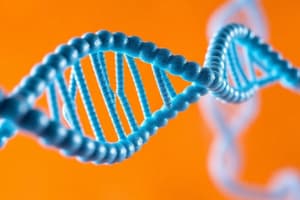Podcast
Questions and Answers
What is resolution in microscopy?
What is resolution in microscopy?
- The method of specimen preparation for viewing.
- The maximum magnification achievable by a lens.
- The ability to illuminate specimens using light.
- The ability to distinguish fine detail and structure. (correct)
Which type of microscope uses a series of lenses and visible light to examine very small specimens?
Which type of microscope uses a series of lenses and visible light to examine very small specimens?
- Compound Light Microscope (correct)
- Bright-field Microscope
- Dark-field Microscope
- Phase Contrast Microscope
What advantage does a Phase Contrast Microscope provide?
What advantage does a Phase Contrast Microscope provide?
- It requires staining for clear images.
- It produces three-dimensional images automatically.
- It operates without a vacuum environment.
- It allows viewing of specimens with enhanced contrast without stains. (correct)
What is the total magnification with a 40X objective lens and a 10X ocular lens?
What is the total magnification with a 40X objective lens and a 10X ocular lens?
What does a Dark-field Microscope help achieve?
What does a Dark-field Microscope help achieve?
Which type of electron microscope is used to examine structures at the molecular level?
Which type of electron microscope is used to examine structures at the molecular level?
What principle does Electron Microscopy rely on?
What principle does Electron Microscopy rely on?
How does Differential Interference Contrast (DIC) microscopy enhance specimen visibility?
How does Differential Interference Contrast (DIC) microscopy enhance specimen visibility?
What was the conclusion drawn from the Meselson-Stahl experiment regarding DNA replication?
What was the conclusion drawn from the Meselson-Stahl experiment regarding DNA replication?
After one round of semi-conservative DNA replication, what would be the proportion of old and new DNA double helices?
After one round of semi-conservative DNA replication, what would be the proportion of old and new DNA double helices?
In which model does every round of replication produce hybrids of original and new DNA?
In which model does every round of replication produce hybrids of original and new DNA?
How long does it take for E.coli to divide, as used in the Meselson-Stahl experiment?
How long does it take for E.coli to divide, as used in the Meselson-Stahl experiment?
What was observed in sample no. 1 after 20 minutes of the Meselson-Stahl experiment?
What was observed in sample no. 1 after 20 minutes of the Meselson-Stahl experiment?
What happens to the number of completely original DNA double helices as replication continues?
What happens to the number of completely original DNA double helices as replication continues?
Which observation was noted in sample no. 2 after 40 minutes of the Meselson-Stahl experiment?
Which observation was noted in sample no. 2 after 40 minutes of the Meselson-Stahl experiment?
Which type of DNA replication model is characterized by retaining the entire original strand?
Which type of DNA replication model is characterized by retaining the entire original strand?
What is the resolving power of a Transmission Electron Microscope (TEM)?
What is the resolving power of a Transmission Electron Microscope (TEM)?
Which of the following stains is commonly used in preparing thin sections for viewing internal cell structures?
Which of the following stains is commonly used in preparing thin sections for viewing internal cell structures?
What type of specimens can be observed using Scanning Electron Microscopy (SEM)?
What type of specimens can be observed using Scanning Electron Microscopy (SEM)?
What is the primary purpose of staining thin sections in electron microscopy?
What is the primary purpose of staining thin sections in electron microscopy?
Which shape is NOT a typical form of bacteria?
Which shape is NOT a typical form of bacteria?
What type of bacteria has a thick peptidoglycan layer surrounding its plasma membrane?
What type of bacteria has a thick peptidoglycan layer surrounding its plasma membrane?
What distinguishes Gram-negative bacteria from Gram-positive bacteria?
What distinguishes Gram-negative bacteria from Gram-positive bacteria?
Which of the following is true about prokaryotic cells?
Which of the following is true about prokaryotic cells?
What is a defining feature of prokaryotes in terms of their cellular structure?
What is a defining feature of prokaryotes in terms of their cellular structure?
Which of the following is true about eukaryotic cells?
Which of the following is true about eukaryotic cells?
Which school of thought emphasizes that the whole is greater than the sum of its parts?
Which school of thought emphasizes that the whole is greater than the sum of its parts?
Molecular biology focuses primarily on which aspect of living organisms?
Molecular biology focuses primarily on which aspect of living organisms?
What is a common problem faced in biological studies related to genetic material?
What is a common problem faced in biological studies related to genetic material?
Which of the following approaches analyzes biological phenomena by breaking them down into their molecular components?
Which of the following approaches analyzes biological phenomena by breaking them down into their molecular components?
Which type of cell organization is characteristic of prokaryotes?
Which type of cell organization is characteristic of prokaryotes?
What is the major focus of microbial genetics within molecular biology?
What is the major focus of microbial genetics within molecular biology?
What is the diameter of a DNA double helix?
What is the diameter of a DNA double helix?
Which helix type is known for its left-handed rotation?
Which helix type is known for its left-handed rotation?
How many base pairs are present in one complete turn of a B-form DNA helix?
How many base pairs are present in one complete turn of a B-form DNA helix?
Which base is present in RNA but not in DNA?
Which base is present in RNA but not in DNA?
What type of environment is formed by the hydrophobic associations of base pairs in a DNA molecule?
What type of environment is formed by the hydrophobic associations of base pairs in a DNA molecule?
In which condition is the A-type helix mainly found?
In which condition is the A-type helix mainly found?
What is the distance between base pairs in a double helix?
What is the distance between base pairs in a double helix?
Which of the following statements is true regarding the major and minor grooves of a DNA helix?
Which of the following statements is true regarding the major and minor grooves of a DNA helix?
Study Notes
DNA Replication Models
- Second Round Replication: Double helices copied entirely, leading to one-quarter old and three-quarters new DNA.
- Dispersive Model: Each replication results in hybrid DNA, combining original and new segments; subsequent replications yield increased new DNA content.
Meselson-Stahl Experiment
- Conducted in 1958 by Meselson and Stahl on E. coli, dividing every 20 minutes.
- First sample after 20 minutes showed intermediate density DNA.
- Second sample after 40 minutes displayed both intermediate and light densities.
- Confirmed DNA replication is semiconservative, where each double helix contains one original and one new strand.
Light Microscopy
- Resolution: Ability to distinguish fine detail; important for observing structures.
- Types of Light Microscopy:
- Compound Light Microscope: Uses visible light, examines small specimens.
- Bright-field Microscope: Observes living cells against a dark background.
- Phase Contrast Microscope: Enhances contrast without staining.
- Differential Interference Contrast: Provides a 3D effect, ideal for electrophysiology.
- Dark-field Microscope: Illuminates from an angle, highlighting objects against a dark field.
Calculating Total Magnification
- Total magnification = Objective lens magnification × Ocular lens magnification.
- Common objective lenses: 10X, 40X, 100X (oil immersion); ocular lenses typically magnify by 10.
Electron Microscopy
- Utilizes electrons for enhanced imaging, using electromagnets as lenses in a vacuum.
- Types of Electron Microscopy:
- Transmission Electron Microscope (TEM): High magnification and resolution, resolving power ~0.2 nm; requires thin, stained sections.
- Scanning Electron Microscopy (SEM): Coats specimens with heavy metals like gold, allowing observation of larger samples with good depth of field.
Prokaryotic Cell Organization
- Prokaryotes: Unicellular organisms, no membrane-bound nucleus; includes eubacteria and archaebacteria.
- Bacteria can be classified by shape: cocci (spherical), bacilli (rod-shaped), spirilla (helical).
- Cell Wall Composition: Comprised largely of peptidoglycan.
- Gram Staining:
- Gram-positive: Thick peptidoglycan layer (20-80 nm).
- Gram-negative: Thinner peptidoglycan (5-10 nm) with outer membrane.
Prokaryotes vs Eukaryotes
- DNA Location: Prokaryotes have DNA in nucleoid region; eukaryotes have membrane-bound nuclei.
- Size: Prokaryotes are generally smaller, eukaryotes larger.
- Organization: Prokaryotes are usually unicellular, eukaryotes often multicellular.
- Metabolism: Prokaryotes may not require oxygen, while eukaryotes generally do.
- Organelles: Prokaryotes lack membrane-bound organelles; eukaryotes possess them.
Early Schools of Thought on Biological Processes
- Vitalism: Intact cells harbor a vital force.
- Mechanism: Cells dissected like machines.
- Holism: The whole surpasses merely the parts.
- Reductionism: Biological phenomena can be reduced to molecular and atomic levels.
Molecular Biology
- Definition: Focuses on genes, their products, and mechanisms in living organisms.
- Research Areas:
- Biochemistry: Physical and chemical structures of biomolecules.
- Microbial Genetics: Study of genetic material transmission and expression.
Historical Problems in Molecular Biology
- Identification of genetic material.
- Synthesis of macromolecules.
- Mechanisms of DNA replication and gene expression.
- Transport of substances across cell membranes.
Approaches to Understanding DNA Structure
- Antiparallel strands of nucleotides; consistent diameter and specific base pair relationships.
- Major and minor grooves essential for protein binding.
- Constant helical diameter (20 Å); hydrophobic bases enhance stability through non-polar interactions.
DNA Conformations
- Different helical types (A, B, C, D, Z) characterized by physical properties (e.g., rotation, base pairs per turn).
- B-DNA: Common form, 10 base pairs per turn; 20 Å diameter.
- Z-DNA: Left-handed helix, alternating base pairs with unique grooves.
Ribonucleic Acid (RNA)
- Primarily single-stranded, ribose sugar, contains C, G, A, and U (uracil).
- Can form various secondary structures, including RNA-DNA hybrids and double-stranded regions.
Peculiar Nucleic Acid Sequences
- Specialized sequences can lead to functional variations in RNA folding and interaction.
Studying That Suits You
Use AI to generate personalized quizzes and flashcards to suit your learning preferences.
Related Documents
Description
Explore the fascinating models of DNA replication, including the semiconservative method supported by the Meselson-Stahl experiment. Learn about different light microscopy techniques and their significance in biological studies. This quiz covers key concepts in cellular biology and microscopy.




